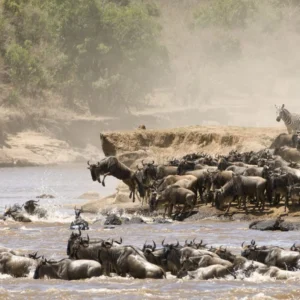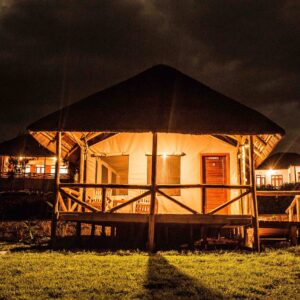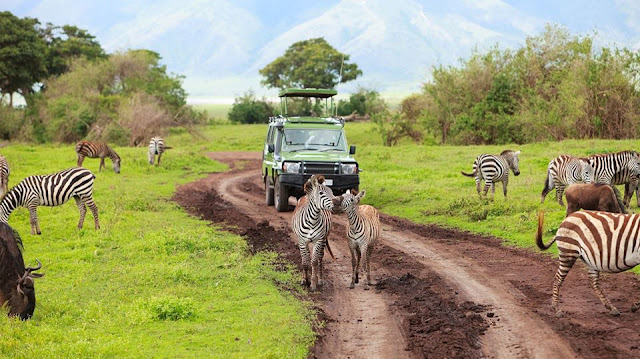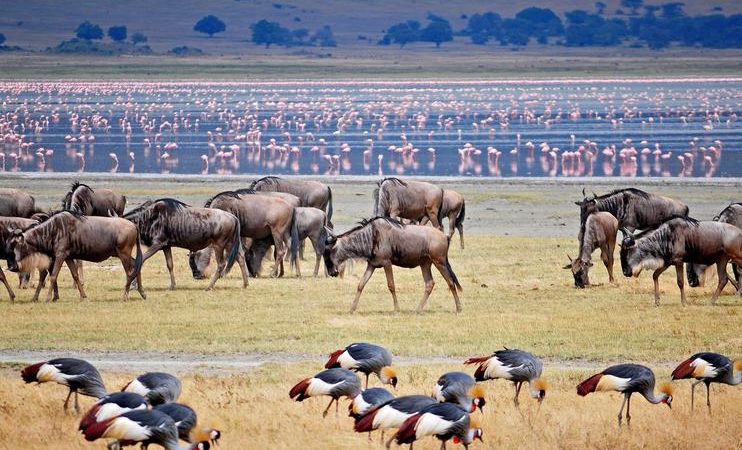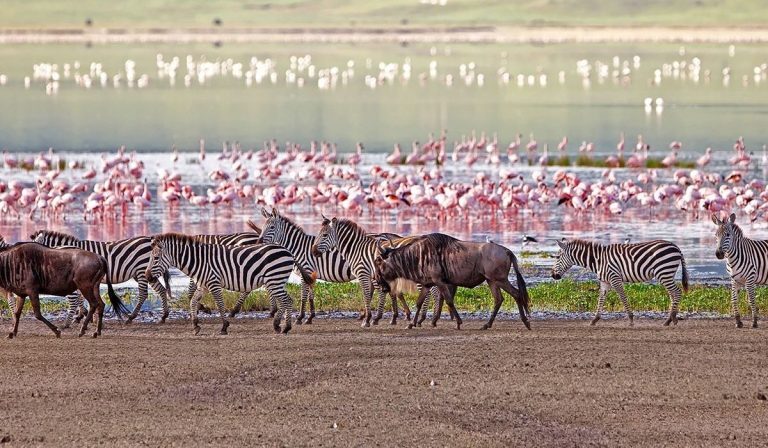The Serengeti National Park. The very name evokes images of raw wilderness, endless horizons, and the dramatic dance of life and death played out by millions of wild animals. Located in northern Tanzania, the Serengeti is not just a national park; it’s a living legend, a UNESCO World Heritage Site, and arguably the most iconic safari destination on Earth. Its vast plains are the stage for the Great Wildebeest Migration, a spectacle of unparalleled scale and power that draws adventurers from across the globe. For any traveler dreaming of an authentic African safari, the Serengeti is an absolute must-visit. This guide provides a comprehensive overview, offering essential tips and insights to help you plan the ultimate journey into the heart of this magnificent wilderness.
1. Overview of Serengeti National Park: An Ecosystem Unrivaled
The Serengeti National Park spans approximately 14,763 square kilometers (5,700 square miles) of diverse landscapes, from vast grasslands and savannas to riverine forests and acacia woodlands. Its name, derived from the Maasai word “Siringet,” meaning “the place where the land runs on forever,” perfectly captures its boundless essence. The park is a cornerstone of the larger Serengeti ecosystem, which includes the Ngorongoro Conservation Area and Kenya’s Maasai Mara. It’s renowned for its exceptional biodiversity, particularly its large predator populations and, of course, the annual Great Wildebeest Migration.
2. The Best Time to Visit the Serengeti National Park
While the Serengeti offers incredible wildlife viewing year-round, the “best” time often depends on what you wish to see: Dry Season (June to October). This is generally considered the prime time for wildlife viewing. The grass is shorter, making animals easier to spot, and they congregate around permanent water sources. This period also coincides with the dramatic Mara River crossings of the Great Migration (typically July to October), where wildebeest brave crocodile-infested waters. Wet Season (November to May). The “Green Season” brings lush landscapes and lower visitor numbers. From January to March, the southern Serengeti (Ndutu area) becomes the calving season hotspot for the Great Migration, with thousands of wildebeest calves born daily, attracting a high concentration of predators. Birdwatching is also excellent during this time as migratory birds arrive.
3. How to Get to Serengeti National Park
Reaching the Serengeti typically involves a combination of flying and driving. To reach Serengeti National Park, you can either fly into a local airstrip within the park, or drive from Arusha or other nearby towns. Flying is generally faster, with options from Kilimanjaro International Airport (JRO), Arusha Airport (ARK), or even Zanzibar. Driving can take 7-8 hours from Arusha, potentially including stops at other attractions like Lake Manyara or Ngorongoro Crater.
By Air. The most common approach is to fly into Kilimanjaro International Airport (JRO), near Arusha. From there, you’ll take a domestic light aircraft flight to one of the Serengeti’s numerous airstrips (e.g., Seronera, Kogatende, Sasakwa). This is the quickest and most convenient option.
By Road. It’s possible to drive from Arusha, often as part of a longer safari itinerary that includes other northern circuit parks like Tarangire and Ngorongoro. The drive can be long and dusty but offers a chance to see more of the Tanzanian countryside. Most reputable safari operators will arrange all your transfers and internal flights.
4. Top Activities to Do in Serengeti National Park
The Serengeti offers a range of activities designed to immerse you in its wild beauty. The Serengeti National Park offers a variety of activities for visitors, with game drives and witnessing the Great Migration being the most popular. Other top activities include hot air balloon safaris, bird watching, cultural visits to Maasai villages, and exploring the Olduvai Gorge.
Game Drives. The primary activity. Early morning and late afternoon drives are best for spotting wildlife when animals are most active. Your experienced guide will navigate the vast plains, tracking animals and providing insights. Hot Air Balloon Safari. An unforgettable experience. Soar silently above the plains at dawn, witnessing the landscape and wildlife from a breathtaking aerial perspective, often followed by a champagne breakfast in the bush.
Walking Safaris. Offered in specific concession areas outside the main park or in certain private reserves. These guided walks (always with armed rangers) allow for a deeper connection with the smaller details of the bush. Cultural Visits. Some itineraries include respectful visits to Maasai villages on the park’s fringes, offering insight into their traditional way of life.
5. Where to Stay in Serengeti National Park
Accommodation options in the Serengeti cater to all budgets and preferences, from basic campsites to ultra-luxury lodges. To plan where to stay in the Serengeti. Consider factors like the Great Migration’s location, your budget, and preferred style of accommodation. Options range from luxury lodges and tented camps to mobile camps that follow the migration. Popular choices include Four Seasons Safari Lodge Serengeti, Singita Sasakwa Lodge, and various mobile camps like Serengeti Under Canvas.
Luxury Lodges. Offer opulent rooms, gourmet dining, swimming pools, and often private decks with stunning views. Tented Camps (Mid-Range to Luxury). Provide a more authentic safari feel without sacrificing comfort. These “tents” are often spacious, with proper beds, en-suite bathrooms, and sometimes even private verandas.
Mobile Camps. These camps move with the Great Migration, offering prime viewing opportunities throughout the year. They provide a high level of comfort while being closer to the action. Budget Campsites. Basic public or private campsites for those on a tighter budget, requiring your tour operator to provide camping gear. Choosing a reputable tour operator is key, as they will select accommodations best suited to your budget and the migration’s location during your visit.
6. What to Pack for Visiting Serengeti National Park
Packing smart is essential for a comfortable safari: When preparing for a Serengeti safari, pack light, breathable clothing in neutral colors like khaki, green, or beige, as these colors blend well with the environment and help to minimize the visibility of dust. Don’t forget essentials like a wide-brimmed hat, sunglasses with good UV protection, comfortable walking shoes, and a lightweight, waterproof and windproof jacket for cooler mornings and evenings. Insect repellent, sunscreen, and a first-aid kit are also crucial.
Clothing. Layers are key. Neutral colors (khaki, olive green, tan, brown) are best. Pack moisture-wicking base layers, warm fleece/puffy jacket for chilly mornings/evenings, and a waterproof/windproof outer shell. Long sleeves and pants offer sun and insect protection. Footwear. Comfortable, well-broken-in closed-toe shoes (sneakers or light hiking boots) for game drives and around camp, plus sandals for relaxation.
Sun Protection. Wide-brimmed hat, sunglasses, high SPF sunscreen, lip balm with SPF. Essentials. Binoculars (non-negotiable!), camera with telephoto lens, extra batteries/memory cards, power bank, headlamp, insect repellent (with DEET), personal first aid kit, reusable water bottle. Luggage. A soft-sided duffel bag is highly recommended, especially if flying on light aircraft (due to strict weight limits, often 15-20kg).
7. Travel Tips for Serengeti National Park
Book with a Reputable Operator: This is the single most important tip. They handle permits, guides, vehicles, and safety. To maximize your Serengeti National Park experience, plan your trip around the Great Migration, book accommodations and tours in advance, and pack appropriately for the weather and activities. Consider visiting during the low or green season (November to March) to avoid crowds and still enjoy good game viewing, including the mega-herds of the migration.
Hydrate. Drink plenty of water throughout the day, especially in the dry heat. Patience. Wildlife viewing requires patience. Not every drive will yield immediate sightings. Listen to Your Guide. Always follow your guide’s instructions regarding wildlife encounters and safety protocols. Tipping. Budget for tips for your guide, cook, and camp staff. Respect the Wildlife. Maintain a respectful distance and avoid loud noises or sudden movements.
8. Serengeti National Park Safety & Sustainability
The Serengeti is generally very safe for tourists due to the presence of experienced guides and strict park regulations. However, always remain in your safari vehicle unless explicitly permitted by your guide. While crime is rare within the park, it’s always wise to be mindful of your belongings and take necessary precautions. The park faces sustainability challenges like poaching, climate change, and habitat loss, but ongoing conservation efforts are crucial for its future.
Sustainability. Choose tour operators committed to responsible tourism. This includes respecting wildlife, minimizing environmental impact (e.g., no littering, staying on designated tracks), and supporting local communities. Conservation efforts are paramount to preserving the Serengeti’s future.
9. Wildlife & Animals in Serengeti National Park
The Serengeti is home to an astonishing array of wildlife, making it a dream destination for animal lovers. Serengeti National Park is renowned for its incredible biodiversity and is home to a wide array of wildlife, including the iconic “Big Five” (lions, elephants, leopards, buffalo, and rhinos). The park also hosts diverse ecosystems, from open savannas to woodlands and riverine forests, which support various animal species. The park is also famous for the Great Migration, where over 1.5 million wildebeest, 200,000 zebras, and 300,000 Thomson’s gazelles migrate annually.
The Big Five. Lion, Leopard, African Elephant, African Buffalo, and Black Rhinoceros. The Great Migration. Millions of Blue Wildebeest, Plains Zebras, and Thomson’s Gazelles. Predators. Cheetahs, Spotted Hyenas, African Wild Dogs (rare but present). Other Mammals. Giraffes, Topi, Eland, Grant’s Gazelle, Common Warthogs, Hippos, Nile Crocodiles. Birdlife. Over 500 species, including Ostriches, Kori Bustards, and Secretary Birds.
10. Serengeti National Park Nearby Attractions
The Serengeti is part of a rich northern safari circuit. Serengeti National Park offers a variety of nearby attractions, including other national parks like Tarangire and Lake Manyara, the Ngorongoro Conservation Area, and the historical Olduvai Gorge. Within the Serengeti itself, visitors can explore the Seronera River Valley, Moru Kopjes, Grumeti River, and Lobo Valley, all known for their unique landscapes and wildlife viewing opportunities.
Ngorongoro Conservation Area. Home to the famous Ngorongoro Crater. Olduvai Gorge. The “Cradle of Mankind,” a crucial paleoanthropological site. Lake Manyara National Park. Known for tree-climbing lions and diverse birdlife. Tarangire National Park. Famous for elephants and baobabs. Mount Kilimanjaro. Africa’s highest peak, visible from parts of the Serengeti.
11. Conservation Efforts in Serengeti National Park
The Serengeti plays a critical role in global conservation. It is a UNESCO World Heritage Site, and its protection is managed by the Tanzania National Parks Authority (TANAPA). Efforts include anti-poaching initiatives, habitat preservation, scientific research, and community engagement to ensure the long-term survival of its unique ecosystem and the Great Migration. Sustainable tourism directly contributes to these vital efforts.
12. Serengeti National Park Travel Guide (Summary)
The Serengeti offers a transformative travel experience. Plan your visit around the Great Migration’s movements if that’s a priority, or choose the Green Season for lush landscapes and fewer crowds. Book with a reputable, all-inclusive tour operator for seamless logistics. Pack light, layer your clothing, and bring good binoculars. Embrace the early mornings and the vastness of the plains. Be prepared for awe-inspiring wildlife encounters and the profound sense of being in one of the last great wildernesses on Earth.
13. What is the Serengeti National Park Famous for?
The Serengeti National Park is primarily famous for the Great Wildebeest Migration, an annual spectacle involving millions of wildebeest, zebras, and gazelles. It’s also renowned for its exceptionally high concentration of predators, particularly lions, and its vast, open savanna landscapes.
14. Fun Facts About Serengeti National Park
Serengeti National Park is famous for the Great Migration, the largest terrestrial mammal migration in the world, featuring over 1.5 million wildebeest and hundreds of thousands of other animals. It’s also known for its high concentration of predators, including the largest lion population in Africa, and for being one of the oldest ecosystems on Earth.
Ancient Name. “Serengeti” comes from the Maasai word “Siringet,” meaning “the place where the land runs on forever.” Size. It covers nearly 15,000 square kilometers, roughly the size of Northern Ireland. UNESCO Status. It was declared a UNESCO World Heritage Site in 1981. Kopjes. Unique granite rock formations (kopjes) dot the plains, providing vital ecosystems and vantage points for predators. Oldest Ecosystem. It’s considered one of the oldest ecosystems on Earth, with its climate and vegetation patterns relatively unchanged for a million years.
Tips for Planning an African Great Migration Safari
How Long Does It Take To See the Serengeti National Park
How to Get to Serengeti National Park – by Car & Flights
Why Serengeti National Park Voted the Best African Safari Destination
Great Migration Safari Packages

